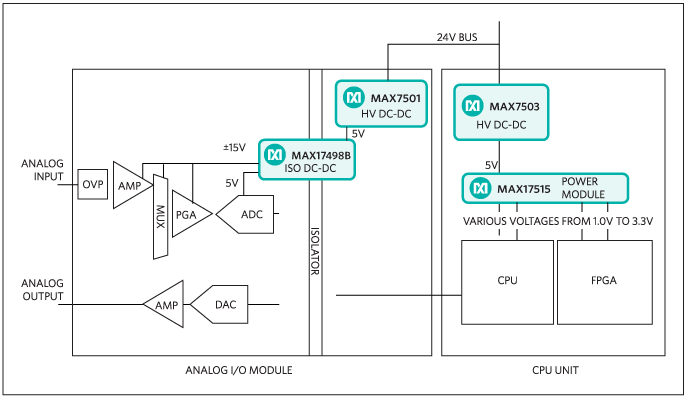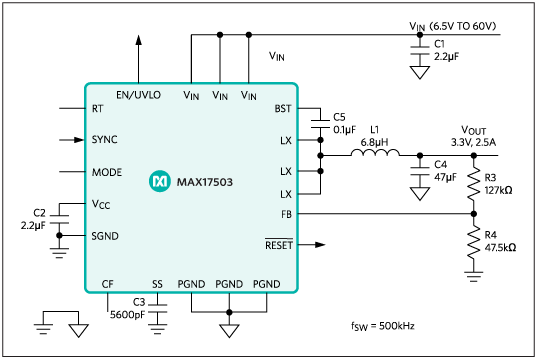Introduction
This application note is Part 2 of a two-part series on high-voltage synchronous regulators in industrial-automation power-supply design. Part 1 discusses the industrial control architecture and the power-supply demands and dilemma. In Part 2 of the series, we discuss how new power supplies incorporate synchronous switching technology, yet can withstand voltage spikes up to 60V and supply up to 3.5A, something that was previously impractical. These capabilities ease industrial automation system power-supply design by improving efficiency and, in turn, lowering heat generation and power consumption, reducing component footprint, and limiting the number of discrete external components.
A New Breed of Synchronous Regulators
Synchronous voltage regulators would seem to be the perfect answer to meet the challenges of industrial-automation system power-supply design. The devices are efficient, limit power consumption, and lower system temperature. They require little space and reduce BOM costs.
There are many synchronous regulators rated for up to 28V operation and a few up to 40V. However, the majority of these devices are particularly sensitive to overvoltage, because there is little margin between their operating and absolute maximum voltage ratings. The voltage spikes endemic to mains-powered systems would likely destroy these components quickly.
One solution is to protect the synchronous regulator with a protective clamp that limits the voltage spikes to a level below the component’s absolute maximum rated voltage. However, these clamps add cost, take up space, and extend the design schedule, thereby negating many of the benefits for using a synchronous regulator in the first place. This presents the industrial automation system engineer with a dilemma: does s/he benefit from the higher efficiency of a synchronous regulator and accept the additional hassle of voltage clamping? Or, does s/he choose an asynchronous regulator that can handle the likely system overvoltages yet consumes more power and gets hotter?
Semiconductor vendors have invested heavily in R&D to resolve this dilemma and a few devices that can handle input voltages up to 60V or even 75V are now entering the market. These devices are, however, limited to just a few hundred milliamps output current, far short of the requirements of much of the equipment used in industrial automation systems, particularly PLCs.
But now, a new generation of high-voltage, high-output-current synchronous regulators has hit the market. An example of these new high-capability chips is the MAX1750x family from Maxim. The devices integrate two MOSFETs and eliminate the external Schottky diode plus its associated external components.
This new synchronous regulator module family can handle up to 60V and offers current outputs including 500mA, 1A, 2.5A, and 3.5A. The company can also supply related products with outputs down to a few tens of milliamps for industrial automation system sensors using a 4–20mA loop.
The MAX17503, for example, is designed to deliver up to 90% efficiency and runs up to 50% cooler than competing high-voltage asynchronous regulators. The device operates over a 4.5V to 60V input voltage range and delivers up to 2.5A output current. Figure 1 shows where the MAX17503 (and sister product, MAX17501) is typically employed in an industrial-automation system.
 Figure 1. Target applications in an industrial automation system for the MAX17501 and MAX17503 DC-DC converters.
Figure 1. Target applications in an industrial automation system for the MAX17501 and MAX17503 DC-DC converters.
Further, the MAX17503 saves up to 50% board space and reduces component count by up to 75%. High-frequency switching from 200kHz to 2.2MHz allows the external inductor to shrink to save more space.
In addition, the MAX1750x regulators incorporate a PFM feature. PFM works by disabling reverse inductor current and skipping pulses at light loads. The advantage of PFM is higher efficiency at light loads because of lower quiescent current (IQ) drawn from the supply.
The high level of integration exhibited by the MAX1750x regulators not only reduces the number of external components and decreases cost, but it also eases the design challenge. There is no need for the engineer to calculate the values for—and source—external capacitors and compensation resistors because the job has already been done for them. Figure 2 shows an application circuit for the chip.
 Figure 2. MAX17503 application circuit for 500kHz switching frequency.
Figure 2. MAX17503 application circuit for 500kHz switching frequency.
Conclusion
In Part 1 of this series, we looked at the industrial control architecture and the demands required of high-voltage synchronous regulators. In Part 2, we focused on the new line of synchronous regulators and the technology to impact power budget issues. By resolving the industrial-automation system power dilemma, a new generation of synchronous regulators has freed engineers to focus on optimizing the operation of their industrial automation systems rather than struggling to come up with a robust power supply. For more information, refer to the MAX17503A Evaluation Kit (for 3.3V output-voltage application) and the MAX17503B Evaluation Kit (for 5V output-voltage application).
Related Parts
MAX17503
4.5V-60V, 2.5A, High-Efficiency, Synchronous Step-Down DC-DC Converter with Internal Compensation
Advertisement
Learn more about Maxim Integrated





